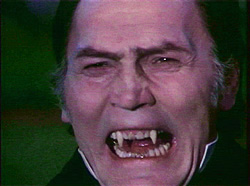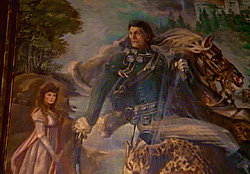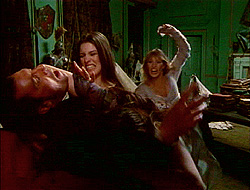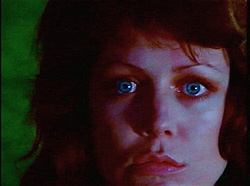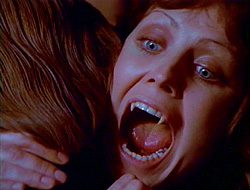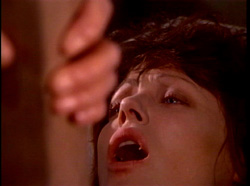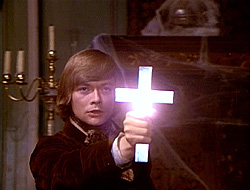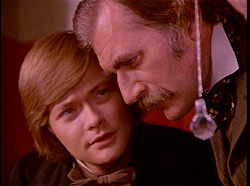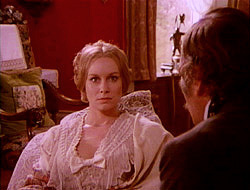|
|
Adaptation
Richard Matheson's script uses much of the original novel (with the
notable omission of the Seward-Renfield-Asylum scenes), including
fragements of the original dialog. However, this version is also notable
for some innovations. One of these is the emphasis on Dracula's historical
namesake, a 15th century Romanian prince whose valor in fighting off the
Turks was equaled only by his sadistic and pscyhopathic violence. This
connection was popularized a year before the movie appeared by Raymond T.
McNally and Radu Florescu's book In Search of Dracula (though I
don't know if Curtis or Matheson saw that book).
Thus in this film version we are given a portion of Dracula's nostalgic speech about fighting off the invaders, and his castle is shown to have a pit lined with upward-pointing stakes (reflecting the historical Dracula's favored method of execution). A written epigraph also suggests that the prince Dracula was reputed to have defeated death.
The other innovation, which Dan Curtis discusses in his interview on the DVD, is the decision to portray Dracula as mourning for a lost love, of whom he perceives Lucy to be the reincarnation. Curtis felt that this gave Dracula a stronger motivation for coming to England, as well as making him a more complex character: sympathetic as well as monstrous. Curtis got this idea from his own Dark Shadows series, but prior to that, the "reincarnated love" idea was the central motif of the horror classic The Mummy in the 1930's, which probably picked it up in turn from H. Rider Haggard's classic novel She.
Anyway, as Curtis points out, the 90's film Bram Stoker's Dracula appropriated this same lost-love idea (as well as the emphasis on the historical Dracula and even the original title of this film, which clearly states "Bram Stoker's Dracula" in the opening credits).
The next most noteworthy element of this version is Jack Palance's (literally) towering portrayal of the Count, who is by turns imperious, seductive, and given to bouts of violent rage. He grimaces a bit too much perhaps, and sometimes seems a bit more American than one would prefer, but he does imbue the character with great vivacity and presence.
Finally the film is noteworthy for its fine locations in England and Yugoslavia and the atmospheric photography of Oswald Morris.
Lapses
There are also some curious limitations to this edition. Van Helsing,
from the wildly eccentric and frequently comic foreign specialist in the
novel, is reduced here to a rather colorless English doctor. An interlude
with Dracula beating up people in a hotel does little to advance the plot.
There is a strange lapse in the continuity: the scene of Mina's arrival at Whitby is followed by
several scenes of things that
apparently happened before her arrival, though there is nothing to suggest
that they were intended as a flashback. In another bizarre scene, Van
Helsing drops his crucifx at Dracula's request, and Van Helsing and
Holmwood then stand idly by while Dracula forces Mina to drink his blood.
After which, Dracula stalks out without attempting to harm the apparently
unarmed heroes.
Themes
The usual genre emphasis on pointy things reaches an extreme in this
production, with Dracula's fangs almost constantly on display, along with
a torture cabinet lined with knives, the pit of stakes, the stakes used to
kill the vampires, and a gigantic spear that Van Helsing wields at the
end. Approaching with the lance, while daylight casts a halo around him,
Van Helsing seems to evoke the mythic Saint George slaying the dragon,
which is appropos – as one meaning of Dracula is "Son of the
Dragon."
In a macabre touch, Lucy is shown with tears on her face, both after first being left dead by Dracula and later after being staked by Van Helsing. She also has a surprisingly slutty expression while being staked.
Vampire Lore
Dracula's powers here include super strength (such as when he bends the
bars of the wolf's cage), casting sleep spells, telepathic control over
his victims, and control over wolves. He asserts when he feeds his blood
to Mina that it is to secure her as his servant. He is visibly pained and
driven back by the sight of crucifixes, repelled by garlic, and weakened
nearly to unconsciousness when exposed to sunlight. However, sunlight
itself does not kill or even visibly burn him. There is no mention of his
being invisible in mirrors, or of needing to be invited before he can
enter a home. In fact, when he sends a wolf crashing through a window, it
is to distract Holmwood rather than to gain entrance to the house.
Inevitably, as he is dispatched by the heroes, Dracula is transformed into a figure of pity, and the stately painting behind him, along with the martial music, suggests a warrior slain in battle rather than merely a monster who has been destroyed.
Dan Curtis' Dracula DVD: Click here for ordering information

